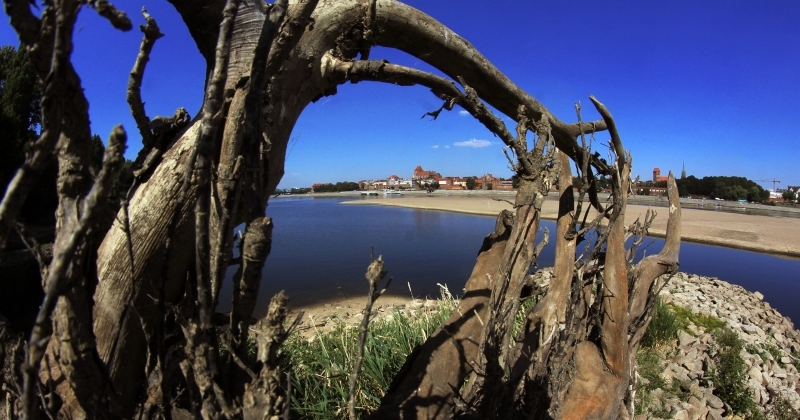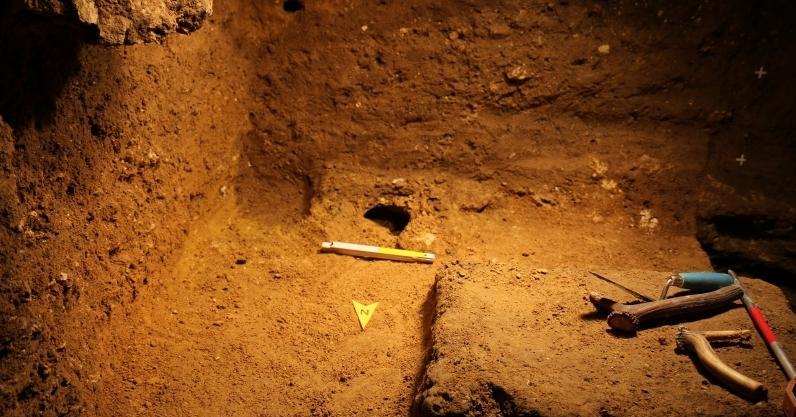 Humanities and arts
Humanities and arts
The history of Upper Mustang written in wood
Almost 300 wood samples from 18 posts, of total weight of 26 kg have been collected in Mustang by Barbara Gmińska-Nowak, M.A. from the Faculty of Fine Arts, UMK. Due to them, she compiled the first for the region standard chronology of Himalayan pine and established what type of wood the first buildings in that region were constructed from.
The Upper Mustang in Nepal is a region located north from the main range of the Himalayas, together with the Dhaulagiri and Annapurna mountain massif. It extends along the Kali Gandaki river, at the altitude of 3500 metres above sea level. These are the lands of the ancient Lo Kingdom. The constructions there used to be erected in stone, clay, and wood. The windows and doors , and additionally exit galleries in palaces were made of wood. Wood is also hidden in the construction of the walls. Ridge bars were used as a toughening divider which protected buildings from the results of earthquakes. The wood is more visible in the interiors. It was used most of all to make barring, bulky slabs and pillars. Temple ceilings are richly ornamented, and the barring expanded and decorated with reliefs and polychromes.
When carrying out the project “Wood in architecture and art of Upper Mustang/Nepal. Dendrochronological research and conservation problems." , Barbara Gmińska-Nowak, M.A., who is a PhD student in the Faculty of Fine Arts UMK, visited the country of Nepal twice. She and her team collected samples from twelve objects, mainly temples (Thupchen Gompa and Jampa Lakhang in Lo Mathang, Ghar Gompa in Lo Geghar, ruins of gompa in Samdroling, old gompa in Namyal, Gharpu Gompa in Choser, KunSan Chholing Gompa in Chuksang), but also from three palaces (Lo Mathang, Tsarang, and Thinggar) and two houses (Lo Manthang and Chuksang).
The first challenge in the project was field research in a hardly available and preserved area – says Gmińska-Nowak.. – I was given the permission to collect the samples from the most precious objects in Lo Manthang by the king Jigme Palbar Bista himself and the superior of Lo Manthang monasteries – Kempo Kunga Tenzin. In total, during the field research organised in cooperation with the Department of Archaeology in Katmandu, I visited eighteen posts where I collected a unique set of almost 300 samples of wood, including historical wood, contemporary wood, and samples from live trees. My collection also contained process samples from archaeological posts.
The PhD student, whose doctoral supervisor is Tomasz Ważny, DSc, collected the samples with the use of three methods: she made boreholes with manual incremental drills, obtaining in this way samples in a form of “pencils" of diameter of 5mm, she used special drills for historical dry wood, and “cutting pencils" of diameter of 7mm she would cut off whole plasters of wood. – I did not decide to make thicker boreholes because the conditions in that region are very specific, the local people remain rather distrustful, and I did not want to make an impression of someone who had arrived and vandalised priceless heritage – explains Gmińska Nowak. – Since I am a conservator, I filled the boreholes with specialist putty for wood preservation to leave the place neat and tidy and to calm the people down.
The elements which were removed from the temples in Lo Manthang during the research and which would have never been used, served the researcher to cut of wood plasters on condition they were not carved elements. In case of the latter, she had to make boreholes as taking away a carved plaster is classified as the theft of an artefact. In this way, 26 kg of wood was collected for the research and had to be transported down from the mountains.
– Once I had everything measured and checked, I was making the chronologies for particular buildings and I started comparing them to one another. – says Gmińska-Nowak. – It was comparing the chronologies of the buildings, but also comparing single samples to the rest of the material, so as to set a date for each sample.
The samples were first transported to the Department of Archaeology in Katmandu, and a month later to the University in Toruń. It was where the PhD student prepared the wood for examination: she grinded and polished the cross section of the wood so as to make the wood gains clearly visible. She identified the samples in a macroscopic and microscopic examination by making the formulations of wood and studying them in magnification mode. She divided the wood into groups according to its species and the building it came from. Afterwards, with the application of specialist equipment, there came the process measuring the annual wood gains. – Once I had everything measured and checked, I was making the chronologies for particular buildings and I started comparing them to one another. – says Gmińska-Nowak. – It was comparing the chronologies of the buildings, but also comparing single samples to the rest of the material, so as to set a date for each sample.
In order to construct chronology for a particular geographical region, where certain climatic conditions prevail, the process usually begins with the examination of live trees. The material is obtained from the oldest trees and a chronology typical for the region is made. It contains all characteristic climatic signals as trees of the same species growing in the same territory react in the same or similar way to the outer factors such as: temperature, humidity, droughts, and floods. Due to this regularity, it is possible to compare the sequences measured from a single tree and therefore date year to year. From the growing trees , according to their species, one can set a chronology which dates back even hundreds of years. Later on, one must continue it by collecting the wood from historical buildings in order to be able to combine the rings end-joined. – In short, it looks as if by drilling into a tree today, I see the rings from 2019 and before this time, I know the date of emergence of each wood gain up to yearly precision - explains Gmińska-Nowak. – The sample of a live tree dates back, let us say, 1712. Next, I take a sample from a historical tree from the period between years 1600-1800. Due to this, I get almost 100 yeas of an extra margin (1712-1800) and chronology which dates back as far as 1600. And this is how , using this method of end-joining, I proceed further and further to older samples. In this way I went back in Upper Mustang to the year of 1317. This is the last wood gain in my oldest wood sample, the age of which I can establish up to yearly precision.

In this way, the UMK PhD student established the first standard chronology of the Himalayan pine for Upper Mustang comprising the period from 1317 to 1943, which allows to date the wood from the territory of former Lo Kingdom. – I was lucky that in the buildings I was examining, I found various wood from the 14th, 16th, 18th, and 19th centuries, and that in case of the pine everything matched. As for the juniper, I was not that lucky any more. Pine trees are the most often used wood species in Upper Mustang, so the most important for me. – points out Gmińska-Nowak.
Despite all this, some samples have never managed to be dated at all, which did not happen due to the fact they were wrong or measured inappropriately. They simply do not originate from this place. – Checking 50 chronologies from neighbouring regions was of no help at all. – explains the PhD student from The Faculty of Fine Arts, UMK. – This means there still exist no related chronologies. For me, it is the future ways I may proceed along.
Due to the analysis of microscopic structure of wood, the researcher identified in the building four species of coniferous wood: Himalayan pine, Himalayan fir, juniper, and larch. The results of the research have shown that the dominant species of wood used in the traditional architecture of Upper Mustang is Himalayan pine. The wood from this species was present in every building examined. It was preferably used in the columns, pillars and massive ceiling joists. Himalayan pine was used to make some elements of the construction in seven buildings. The largest collection of samples of this species comes from the temple of Thupchen Gompa in Lo Manthang.
Himalayan juniper is an astounding tree, the height of which may reach from 12 to even 20 metres.
I was really surprised to see this. – admits Gmińska-Nowak. – I did not realise what kind of trees they are. I showed pictures of them to Achyutowi Tiwari, PhD, dendrochronologist from Tribhuvana University in Kathmandu. He said they were junipers.
This wood was most willingly used for the construction of the royal palace in Tsarang. In the collection of the PhD student from Toruń, there are 11 samples of larch tree. They originate only from two research posts: the part of the royal palace under reconstruction in Lo Manthang, destroyed during the earthquake in 2015 and from Namgyal Gompa under rebuilding process. This wood is probably the contemporary building material. It was imported from a distant location as none of the two Himalayan species of juniper naturally exists in the region of Mustang, nor in its neighbourhood.
In Upper Mustang itself, there are very few trees. – says Gmińska-Nowak. – There are no forests like those we have in Poland. There grow no pine trees, nor did I see fir trees. I found juniper growing, but it is not exactly what I found in the historical wood. The samples of historical wood are definitely dominated by pine tree. The wood for building constructions was probably transported from South Mustang. The transportation from the north is very unlikely. When I was checking on the spread of tree species in the territory Tibet, I did not find this pine tree either. Currently, I cannot prove that 100, 200 or 300 years ago, pine trees grew in Upper Mustang. Nor can I contradict this assumption.
The PhD student had the results of her findings published in the article Dendrochronological analysis of the ancient architecture of Kingdom of Lo. Upper Mustang, Nepal, which appeared in a scientific magazine “Dendrochronologia". The project “Wood in architecture and art of Upper Mustang/Nepal. Dendrochronological research and conservation problems." Was financed by the National Centre of Science.
 NCU News
NCU News







 Natural sciences
Natural sciences
 Humanities and arts
Humanities and arts